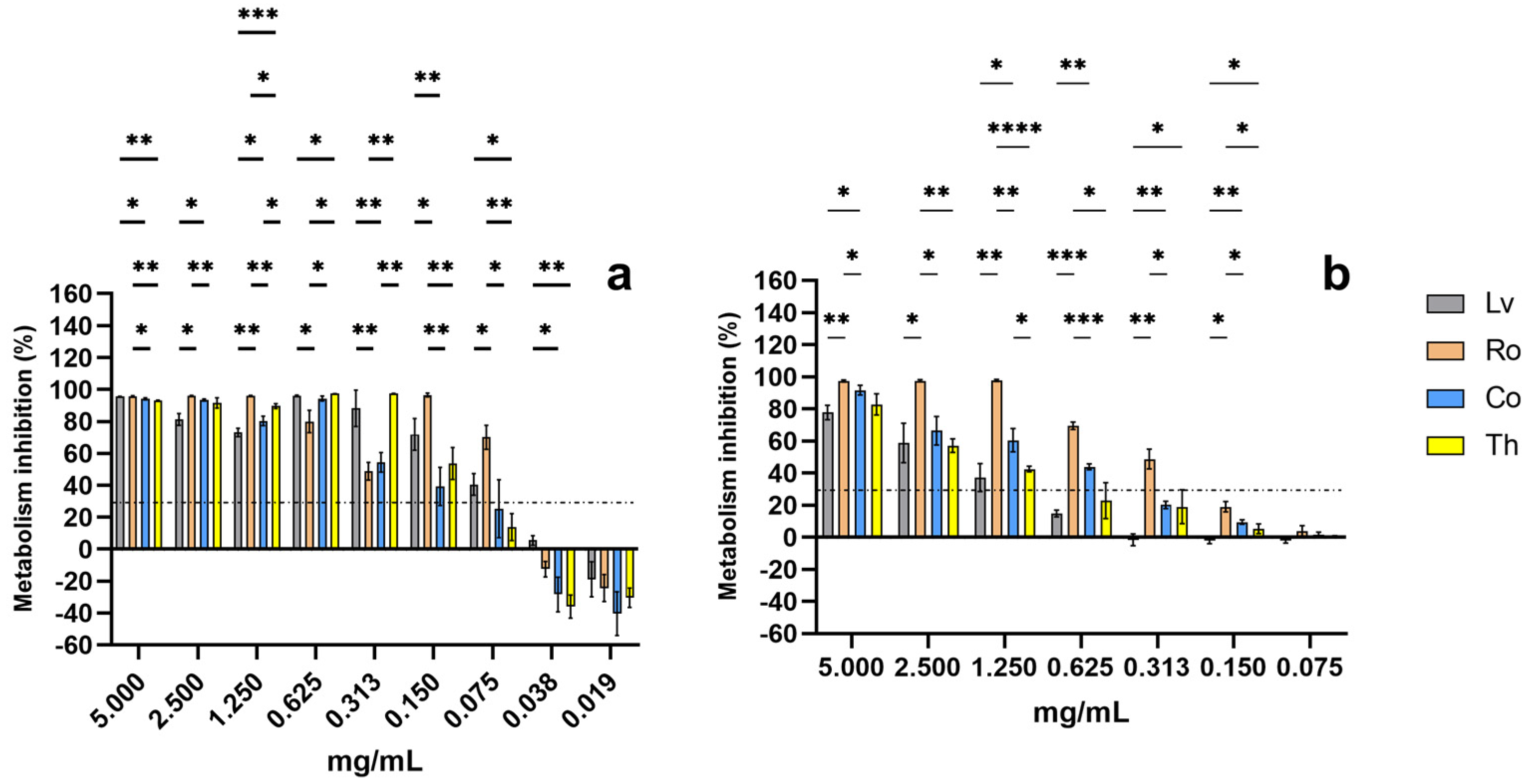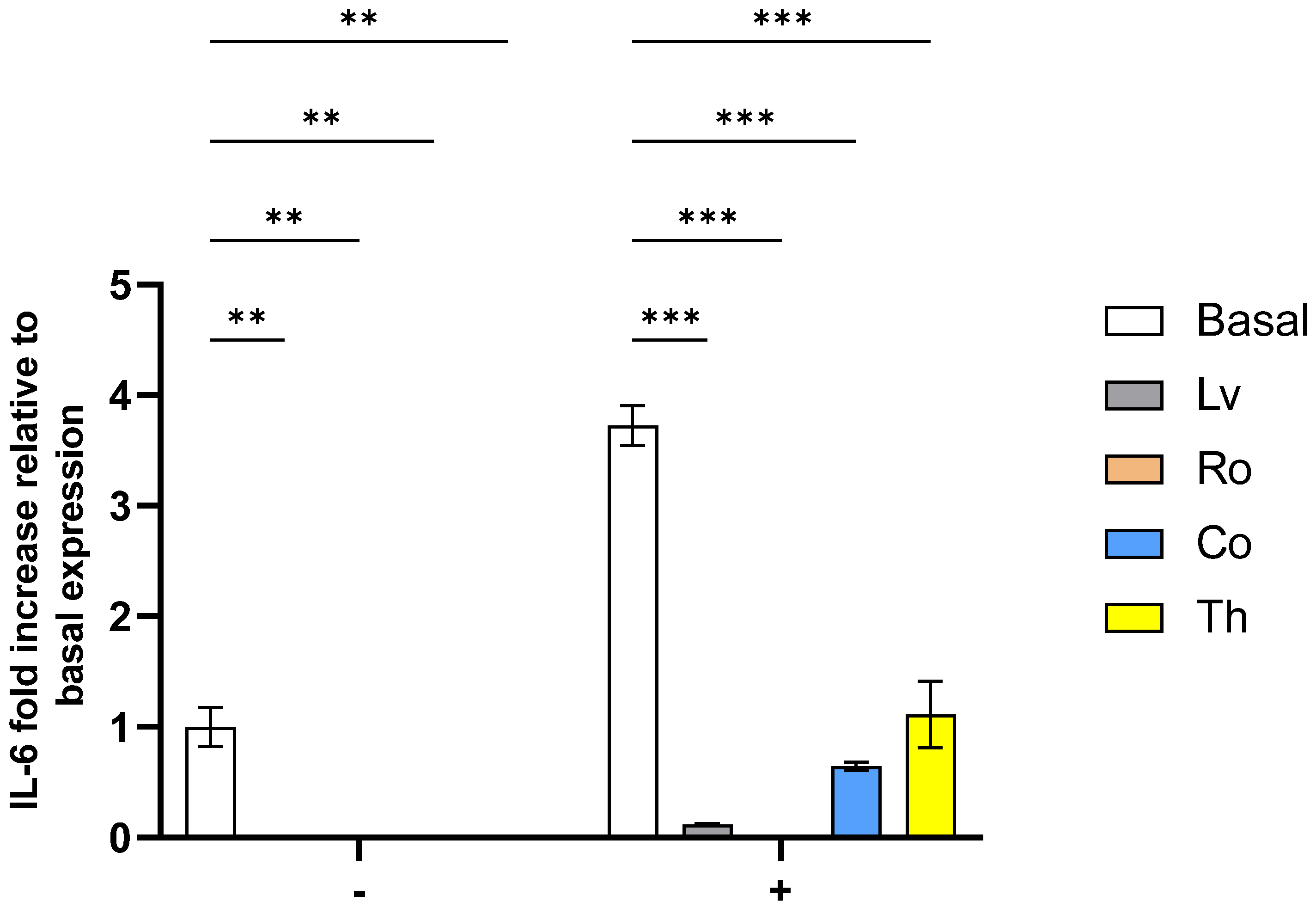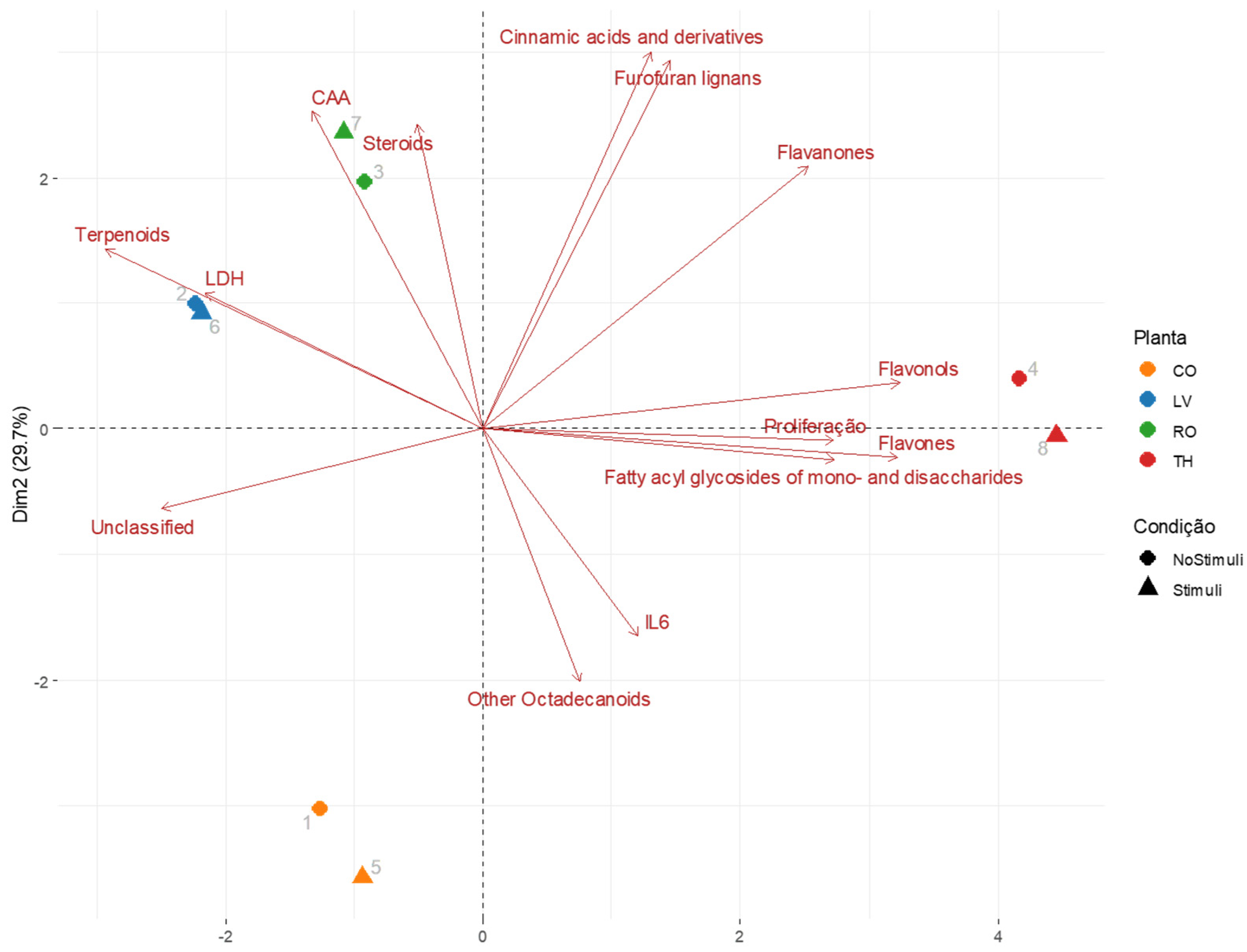Bioactive Aromatic Plant Extracts Modulate Metabolism and Inflammation in HeLa Cells
Abstract
1. Introduction
2. Results and Discussion
2.1. Phenolic Compounds Fingerprinting
2.2. Impact upon Cellular Metabolism
2.3. Membrane Integrity
2.4. Proliferation
2.5. Cellular Antioxidant Activity
2.6. IL-6 Secretion Modulation
2.7. Integrative Data Analysis
3. Materials and Methods
3.1. Chemicals and Raw Materials
3.2. Compound Extraction
3.3. High-Resolution LC-MS and Data Analysis
3.4. Cell Lines Used
3.5. Impact upon Cellular Metabolism
3.6. Impact upon Cell Membrane Integrity
3.7. Impact upon Cellular Proliferation
3.8. Impact upon Intracellular ROS Production
3.9. Modulation of IL-6 Production
3.10. Statistical Analysis
4. Conclusions
Supplementary Materials
Author Contributions
Funding
Institutional Review Board Statement
Informed Consent Statement
Data Availability Statement
Conflicts of Interest
References
- Jain, H.; Aggarwal, N.K. Potential Antioxidant and Antiviral Activities of Various Hydroethanolic Extracts. In Bioactive Ingredients for Healthcare Industry Volume 1: Extraction Strategies, Stability and Medicinal Properties; CRC Press: Boca Raton, FL, USA, 2025; pp. 37–60. [Google Scholar]
- Ares, A.M.; Bernal, J.L.; Nozal, M.J.; Bernal, J. Analysis of herbal bioactives. In Aromatic Herbs in Food: Bioactive Compounds, Processing, and Applications; Academic Press: Cambridge, MA, USA, 2021; pp. 201–232. [Google Scholar]
- Mazumder, A.; Das, S. Ethanopharmacological Activities of Mentha arvensis: An Updated Review. Int. J. Drug Deliv. Technol. 2023, 13, 1650–1656. [Google Scholar] [CrossRef]
- Olivero-Verbel, J.; Quintero-Rincón, P.; Caballero-Gallardo, K. Aromatic plants as cosmeceuticals: Benefits and applications for skin health. Planta 2024, 260, 132. [Google Scholar] [CrossRef]
- Gonçalves, S.; Mansinhos, I.; Romano, A. Aromatic plants: A source of compounds with antioxidant and neuroprotective effects. In Oxidative Stress and Dietary Antioxidants in Neurological Diseases; Academic Press: Cambridge, MA, USA, 2020; pp. 155–173. [Google Scholar]
- Ozdal, T.; Tomas, M.; Toydemir, G.; Kamiloglu, S.; Capanoglu, E. Introduction to nutraceuticals, medicinal foods, and herbs. In Aromatic Herbs in Food: Bioactive Compounds, Processing, and Applications; Academic Press: Cambridge, MA, USA, 2021; pp. 1–34. [Google Scholar]
- Al-Obaidi, J.R. Proteomics research in aromatic plants and its contribution to the nutraceuticals and pharmaceutical outcomes. In Medicinal and Aromatic Plants: Expanding Their Horizons Through Omics; Academic Press: Cambridge, MA, USA, 2020; pp. 223–239. [Google Scholar]
- Jagatap, V.; Ahmad, I.; Kaikini, A.; Patel, H. Essential oils as anticancer agents. In Recent Frontiers of Phytochemicals: Applications in Food, Pharmacy, Cosmetics, and Biotechnology; Elsevier: Amsterdam, The Netherlands, 2023; pp. 629–643. [Google Scholar]
- Vallejo, M.J.; Salazar, L.; Grijalva, M. Oxidative stress modulation and ROS-mediated toxicity in cancer: A review on in vitro models for plant-derived compounds. Oxidative Med. Cell. Longev. 2017, 2017, 4586068. [Google Scholar] [CrossRef] [PubMed]
- Tan, W.N.; Samling, B.A.; Tong, W.Y.; Chear, N.J.Y.; Yusof, S.R.; Lim, J.W.; Tchamgoue, J.; Leong, C.R.; Ramanathan, S. Chitosan-Based Nanoencapsulated Essential Oils: Potential Leads against Breast Cancer Cells in Preclinical Studies. Polymers 2024, 16, 478. [Google Scholar] [CrossRef]
- Yuan, Y.; Li, Y.; Deng, Q.; Yang, J.; Zhang, J. Selenadiazole-Induced Hela Cell Apoptosis through the Redox Oxygen Species-Mediated JAK2/STAT3 Signaling Pathway. ACS Omega 2024, 9, 20919–20926. [Google Scholar] [CrossRef]
- Constantin, M.T.; Beleaua, M.A. Recent progress in apoptosis triggering facilitated by HeLa Studies. Acta Marisiensis—Ser. Medica 2023, 69, 98–103. [Google Scholar] [CrossRef]
- Pereira, E.; Pimenta, A.I.; Calhelha, R.C.; Antonio, A.L.; Verde, S.C.; Barros, L.; Santos-Buelga, C.; Ferreira, I.C.F.R. Effects of gamma irradiation on cytotoxicity and phenolic compounds of Thymus vulgaris L. and Mentha x piperita L. LWT—Food Sci. Technol. 2016, 71, 370–377. [Google Scholar] [CrossRef]
- Pereira, E.; Pimenta, A.I.; Calhelha, R.C.; Antonio, A.L.; Barros, L.; Santos-Buelga, C.; Verde, S.C.; Ferreira, I.C.F.R. Infusions of gamma irradiated Aloysia citrodora L. and Mentha x piperita L.: Effects on phenolic composition, cytotoxicity, antibacterial and virucidal activities. Ind. Crops Prod. 2017, 97, 582–590. [Google Scholar] [CrossRef]
- Nie, J.-Y.; Li, R.; Wang, Y.; Tan, J.; Tang, S.-H.; Jiang, Z.-T. Antioxidant activity evaluation of rosemary ethanol extract and their cellular antioxidant activity toward HeLa cells. J. Food Biochem. 2019, 43, e12851. [Google Scholar] [CrossRef]
- Gevrenova, R.; Zengin, G.; Sinan, K.I.; Zheleva-Dimitrova, D.; Balabanova, V.; Kolmayer, M.; Voynikov, Y.; Joubert, O. An In-Depth Study of Metabolite Profile and Biological Potential of Tanacetum balsamita L. (Costmary). Plants 2023, 12, 22. [Google Scholar] [CrossRef]
- ISO E. 10993-5: 2009; Biological Evaluation of Medical Devices—Part 5: Tests for In Vitro Cytotoxicity (ISO 10993-5: 2009). German Version; ISO Central Secretariat: Geneva, Switzerland, 2009.
- Oliveira, J.R.d.; de Jesus Viegas, D.; Martins, A.P.R.; Carvalho, C.A.T.; Soares, C.P.; Camargo, S.E.A.; Jorge, A.O.C.; de Oliveira, L.D. Thymus vulgaris L. extract has antimicrobial and anti-inflammatory effects in the absence of cytotoxicity and genotoxicity. Arch. Oral Biol. 2017, 82, 271–279. [Google Scholar] [CrossRef] [PubMed]
- Berrington, D.; Lall, N. Anticancer Activity of Certain Herbs and Spices on the Cervical Epithelial Carcinoma (HeLa) Cell Line. Evid.-Based Complement. Altern. Med. 2012, 2012, 564927. [Google Scholar] [CrossRef] [PubMed]
- Heidari, Z.; Salehzadeh, A.; Sadat Shandiz, S.A.; Tajdoost, S. Anti-cancer and anti-oxidant properties of ethanolic leaf extract of Thymus vulgaris and its bio-functionalized silver nanoparticles. 3 Biotech 2018, 8, 177. [Google Scholar] [CrossRef]
- Adham, A.N.; Hegazy, M.E.F.; Naqishbandi, A.M.; Efferth, T. Induction of Apoptosis, Autophagy and Ferroptosis by Thymus vulgaris and Arctium lappa Extract in Leukemia and Multiple Myeloma Cell Lines. Molecules 2020, 25, 5016. [Google Scholar] [CrossRef]
- Gonçalves, G.A.; Corrêa, R.C.G.; Barros, L.; Dias, M.I.; Calhelha, R.C.; Correa, V.G.; Bracht, A.; Peralta, R.M.; Ferreira, I.C.F.R. Effects of in vitro gastrointestinal digestion and colonic fermentation on a rosemary (Rosmarinus officinalis L.) extract rich in rosmarinic acid. Food Chem. 2019, 271, 393–400. [Google Scholar] [CrossRef]
- Sharma, G.; Zaidi, Z.; Ali, M.I.; Moin, S. In Vitro Antioxidant and Anticancer Activity of Plant Extracts of Tanacetum dolicophyllum (Kitam.) Kitam. J. Nat. Remedies 2023, 23, 455–465. [Google Scholar] [CrossRef]
- Rashid, H.M.; Mahmod, A.I.; Afifi, F.U.; Talib, W.H. Antioxidant and Antiproliferation Activities of Lemon Verbena (Aloysia citrodora): An In Vitro and In Vivo Study. Plants 2022, 11, 785. [Google Scholar] [CrossRef]
- Qiu, W.X.; Zhang, M.K.; Liu, L.H.; Gao, F.; Zhang, L.; Li, S.Y.; Xie, B.R.; Zhang, C.; Feng, J.; Zhang, X.Z. A self-delivery membrane system for enhanced anti-tumor therapy. Biomaterials 2018, 161, 81–94. [Google Scholar] [CrossRef]
- Regen, S.L. Membrane-Disrupting Molecules as Therapeutic Agents: A Cautionary Note. JACS Au 2021, 1, 3–7. [Google Scholar] [CrossRef]
- Ayesh, B.M.; Abed, A.A.; Faris, D.a.M. In vitro inhibition of human leukemia THP-1 cells by Origanum syriacum L. and Thymus vulgaris L. extracts. BMC Res. Notes 2014, 7, 612. [Google Scholar] [CrossRef] [PubMed]
- Funk, C.M.; Musa, J. Proliferation Assessment by Trypan Blue Exclusion in Ewing Sarcoma. In Methods in Molecular Biology; Humana Press: New York, NY, USA, 2021; Volume 2226, pp. 151–158. [Google Scholar]
- Pereira, E.; Pimenta, A.I.; Barros, L.; Calhelha, R.C.; Antonio, A.L.; Cabo Verde, S.; Ferreira, I.C.F.R. Effects of gamma radiation on the bioactivity of medicinal and aromatic plants: Mentha × piperita L., Thymus vulgaris L. and Aloysia citrodora Paláu as case studies. Food Funct. 2018, 9, 5150–5161. [Google Scholar] [CrossRef]
- Đilas, S.; Knez, Ž.; Četojević-Simin, D.; Tumbas, V.; Škerget, M.; Čanadanović-Brunet, J.; Ćetković, G. In vitro antioxidant and antiproliferative activity of three rosemary (Rosmarinus officinalis L.) extract formulations. Int. J. Food Sci. Technol. 2012, 47, 2052–2062. [Google Scholar] [CrossRef]
- Gaikwad, S.R.; Srivastava, S.K. Antioxidant Activity of Phytochemicals in Cancer. In Handbook of Oxidative Stress in Cancer: Therapeutic Aspects; Springer Nature: Berlin/Heidelberg, Germany, 2022; Volume 1, pp. 81–97. [Google Scholar]
- Dara, M.; Zare-Moayedi, Z.; Taheri, Y.; Tanideh, R.; Zare, S.; Kafilzadeh, F. Exploring herbal preconditioning strategies to improve adipose tissue stem cell therapy efficacy. Gene Rep. 2024, 37, 102030. [Google Scholar] [CrossRef]
- Mihaylova, R.; Gevrenova, R.; Petrova, A.; Savov, Y.; Zheleva-Dimitrova, D.; Balabanova, V.; Momekov, G.; Simeonova, R. Mitigating Effects of Tanacetum balsamita L. on Metabolic Dysfunction-Associated Fatty Liver Disease (MAFLD). Plants 2024, 13, 2086. [Google Scholar] [CrossRef]
- Ding, Z.; Xu, M.; Wu, H.; Raka, R.N.; Wei, M.; Wang, K.; Xiao, J. Inhibitory Effect of Four Bioactive Compounds from Rosemary on Lipopolysaccharide (LPS)-Induced Oxidative Stress and Inflammation in RAW264.7 Cells. Shipin Kexue/Food Sci. 2022, 43, 125–133. [Google Scholar] [CrossRef]
- Sakr, S.A.; Lamfon, H.A. Protective effect of rosemary (Rosmarinus Officinalis) leaves extract on carbon tetrachloride—induced nephrotoxicity in albino rats. Life Sci. J. 2012, 9, 779–785. [Google Scholar]
- Valdés, A.; García-Cañas, V.; Koçak, E.; Simó, C.; Cifuentes, A. Foodomics study on the effects of extracellular production of hydrogen peroxide by rosemary polyphenols on the anti-proliferative activity of rosemary polyphenols against ht-29 cells. Electrophoresis 2016, 37, 1795–1804. [Google Scholar] [CrossRef]
- Pacifico, S.; Piccolella, S.; Papale, F.; Nocera, P.; Lettieri, A.; Catauro, M. A polyphenol complex from Thymus vulgaris L. plants cultivated in the Campania Region (Italy): New perspectives against neuroblastoma. J. Funct. Foods 2016, 20, 253–266. [Google Scholar] [CrossRef]
- Kozics, K.; Klusová, V.; Srančíková, A.; Mučaji, P.; Slameňová, D.; Hunáková, Ľ.; Kusznierewicz, B.; Horváthová, E. Effects of Salvia officinalis and Thymus vulgaris on oxidant-induced DNA damage and antioxidant status in HepG2 cells. Food Chem. 2013, 141, 2198–2206. [Google Scholar] [CrossRef] [PubMed]
- Soliman, M.M.; Aldhahrani, A.; Alghamdi, Y.S.; Said, A.M. Impact of Thymus vulgaris extract on sodium nitrite-induced alteration of renal redox and oxidative stress: Biochemical, molecular, and immunohistochemical study. J. Food Biochem. 2022, 46, e13630. [Google Scholar] [CrossRef] [PubMed]
- Funes, L.; Carrera-Quintanar, L.; Cerdán-Calero, M.; Ferrer, M.D.; Drobnic, F.; Pons, A.; Roche, E.; Micol, V. Effect of lemon verbena supplementation on muscular damage markers, proinflammatory cytokines release and neutrophils’ oxidative stress in chronic exercise. Eur. J. Appl. Physiol. 2011, 111, 695–705. [Google Scholar] [CrossRef]
- Lenoir, L.; Rossary, A.; Joubert-Zakeyh, J.; Vergnaud-Gauduchon, J.; Farges, M.C.; Fraisse, D.; Texier, O.; Lamaison, J.L.; Vasson, M.P.; Felgines, C. Lemon verbena infusion consumption attenuates oxidative stress in dextran sulfate sodium-induced colitis in the rat. Dig. Dis. Sci. 2011, 56, 3534–3545. [Google Scholar] [CrossRef]
- Wu, S.; Cao, Z.; Lu, R.; Zhang, Z.; Sethi, G.; You, Y. Interleukin-6 (IL-6)-associated tumor microenvironment remodelling and cancer immunotherapy. Cytokine Growth Factor Rev. 2025, 85, 93–102. [Google Scholar] [CrossRef]
- Mahmoodi, M.; Ayoobi, F.; Aghaei, A.; Rahmani, M.; Taghipour, Z.; Hosseini, A.; Jafarzadeh, A.; Sankian, M. Beneficial effects of Thymus vulgaris extract in experimental autoimmune encephalomyelitis: Clinical, histological and cytokine alterations. Biomed. Pharmacother. 2019, 109, 2100–2108. [Google Scholar] [CrossRef]
- Oliviero, M.; Romilde, I.; Beatrice, M.M.; Matteo, V.; Giovanna, N.; Consuelo, A.; Claudio, C.; Giorgio, S.; Maggi, F.; Massimo, N. Evaluations of thyme extract effects in human normal bronchial and tracheal epithelial cell lines and in human lung cancer cell line. Chem. -Biol. Interact. 2016, 256, 125–133. [Google Scholar] [CrossRef]
- Khorashadizadeh, N.; Neamati, A.; Moshiri, M.; Etemad, L. Verbascoside inhibits paraquate-induced pulmonary toxicity via modulating oxidative stress, inflammation, apoptosis and DNA damage in A549 cell. Drug Chem. Toxicol. 2022, 45, 2212–2220. [Google Scholar] [CrossRef] [PubMed]
- Mauriz, E.; Vallejo, D.; Tuñón, M.J.; Rodriguez-López, J.M.; Rodríguez-Pérez, R.; Sanz-Gómez, J.; García-Fernández, M.C. Effects of dietary supplementation with lemon verbena extracts on serum inflammatory markers of multiple sclerosis patients. Nutr. Hosp. 2015, 31, 764–771. [Google Scholar] [CrossRef]
- Arranz, E.; Mes, J.; Wichers, H.J.; Jaime, L.; Mendiola, J.A.; Reglero, G.; Santoyo, S. Anti-inflammatory activity of the basolateral fraction of Caco-2 cells exposed to a rosemary supercritical extract. J. Funct. Foods 2015, 13, 384–390. [Google Scholar] [CrossRef]
- Ahmed, A.M.; Ahmed, M.A. The Effect of Rosemary Plant Treated with Fructose on Insulin Sensitivity and Inflammatory Mediators in Male Albino Rats. In Proceedings of the International Conference on Applied Innovation in IT, Köthen, Germany, 12–13 March 2025; pp. 931–937. [Google Scholar]
- Park, M.Y. Carnosic acid disrupts toll-like receptor 2 signaling pathway in Pam3CSK4-stimulated macrophages. Toxicol. Environ. Health Sci. 2015, 7, 224–230. [Google Scholar] [CrossRef]
- Arzuk, E.; Karakuş, F.; Albayrak, G.; Ergüç, A.; Tan, I.; Atiş, E. Effect of n-Hexane Extract from Tanacetum argenteum (Lam.) Willd. subsp. argenteum on the Secretion of Proinflammatory Cytokines in THP-1 Cell Line. Fabad J. Pharm. Sci. 2024, 49, 233–244. [Google Scholar] [CrossRef]
- Magni, P.; Ruscica, M.; Dozio, E.; Rizzi, E.; Beretta, G.; Facino, R.M. Parthenolide inhibits the LPS-induced secretion of IL-6 and TNF-α and NF-κB nuclear translocation in BV-2 microglia. Phytother. Res. 2012, 26, 1405–1409. [Google Scholar] [CrossRef]
- Machado, M.; Silva, S.; Pintado, M.; Costa, E.M. Exploring the Effects of Sweet Potato Leaves on Skin Health—From Antimicrobial to Immunomodulator. Molecules 2025, 30, 855. [Google Scholar] [CrossRef]
- Costa, E.M.; Silva, S.; Veiga, M.; Baptista, P.; Tavaria, F.K.; Pintado, M.E. Textile dyes loaded chitosan nanoparticles: Characterization, biocompatibility and staining capacity. Carbohydr. Polym. 2021, 251, 117120. [Google Scholar] [CrossRef] [PubMed]
- Costa, E.M.; Silva, S.; Tavaria, F.K.; Pintado, M. Insights into the Biocompatibility and Biological Potential of a Chitosan Nanoencapsulated Textile Dye. Int. J. Mol. Sci. 2022, 23, 14234. [Google Scholar] [CrossRef] [PubMed]
- Costa, E.M.; Machado, M.; Pintado, M.; Silva, S. Evaluating pomegranate seed oil for potential topical applications: Safety, anti-inflammatory activity and wound healing in skin cell models. Inflammopharmacology 2025, 6, 52. [Google Scholar] [CrossRef] [PubMed]
- Yano, A.; Yuki, S.; Shiraishi, A.; Hakozaki, M.; Kanno, Y.; Kimura, K.-i.; Uesugi, S. Golden berry leaf extract containing withanolides suppresses TNF-α and IL-17 induced IL-6 expression in HeLa Cells. Biosci. Biotechnol. Biochem. 2023, 87, 972–980. [Google Scholar] [CrossRef]








| Compound Class\Plant | Lv | Ro | Th | Co |
|---|---|---|---|---|
| Alkaloids | - | 2.4 | - | - |
| Catechols with side chains | - | - | 6 | - |
| Chalcones | - | - | - | 3.3 |
| Cinnamic acids and derivatives | 13.6 | 12.0 | 11.9 | 10 |
| Disaccharides/olysaccharides | - | 4.8 | - | - |
| Fatty acyl glycosides of mono- and disaccharides | 6.1 | 7.2 | 8.3 | - |
| Flavanones | 9.1 | 8.4 | 9.5 | 8.3 |
| Flavones | 16.7 | 14.5 | 16.7 | 20 |
| Flavonols | 19.7 | 18.1 | 22.6 | 23.3 |
| Furofuran ligans | - | 3.6 | 3.6 | 3.3 |
| Isoflavones | - | 2.4 | - | - |
| N-acyl amines | 3.0 | - | 2.4 | - |
| Other octadecanoids | 7.6 | 4.8 | 6 | 8.3 |
| Phenylethanoids | 3.0 | - | - | - |
| Polyamines | 1.5 | - | - | - |
| Steroids | 4.5 | - | - | - |
| Shikimic acids and derivatives | - | 2.4 | - | - |
| Simple phenolic acids | - | 3.6 | - | 5 |
| Steroids | - | 2.4 | - | 1.7 |
| Terpenoids | 12.1 | 9.6 | 7.1 | 11.7 |
| Unclassified | 3.0 | 3.6 | 1.2 | 5 |
| Unsaturated fatty acids | - | - | 4.8 | - |
Disclaimer/Publisher’s Note: The statements, opinions and data contained in all publications are solely those of the individual author(s) and contributor(s) and not of MDPI and/or the editor(s). MDPI and/or the editor(s) disclaim responsibility for any injury to people or property resulting from any ideas, methods, instructions or products referred to in the content. |
© 2025 by the authors. Licensee MDPI, Basel, Switzerland. This article is an open access article distributed under the terms and conditions of the Creative Commons Attribution (CC BY) license (https://creativecommons.org/licenses/by/4.0/).
Share and Cite
Silva, S.; Machado, M.; Pintado, M.; Costa, E.M. Bioactive Aromatic Plant Extracts Modulate Metabolism and Inflammation in HeLa Cells. Molecules 2025, 30, 4401. https://doi.org/10.3390/molecules30224401
Silva S, Machado M, Pintado M, Costa EM. Bioactive Aromatic Plant Extracts Modulate Metabolism and Inflammation in HeLa Cells. Molecules. 2025; 30(22):4401. https://doi.org/10.3390/molecules30224401
Chicago/Turabian StyleSilva, Sara, Manuela Machado, Manuela Pintado, and Eduardo M. Costa. 2025. "Bioactive Aromatic Plant Extracts Modulate Metabolism and Inflammation in HeLa Cells" Molecules 30, no. 22: 4401. https://doi.org/10.3390/molecules30224401
APA StyleSilva, S., Machado, M., Pintado, M., & Costa, E. M. (2025). Bioactive Aromatic Plant Extracts Modulate Metabolism and Inflammation in HeLa Cells. Molecules, 30(22), 4401. https://doi.org/10.3390/molecules30224401









